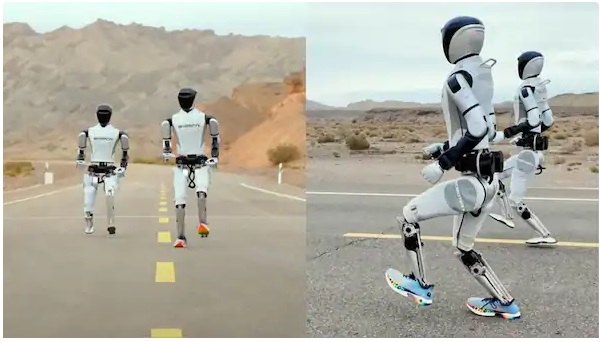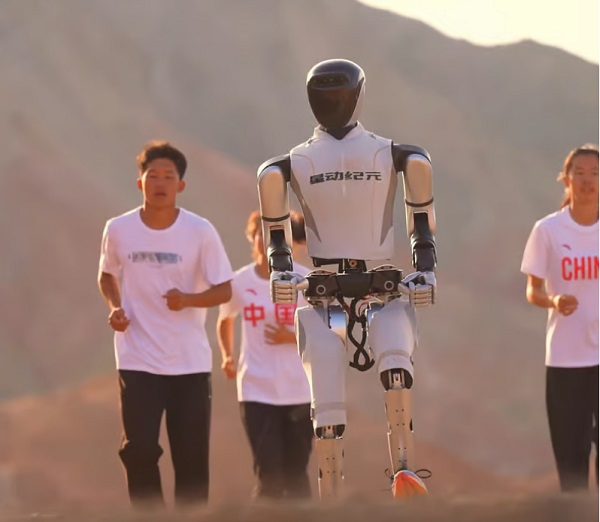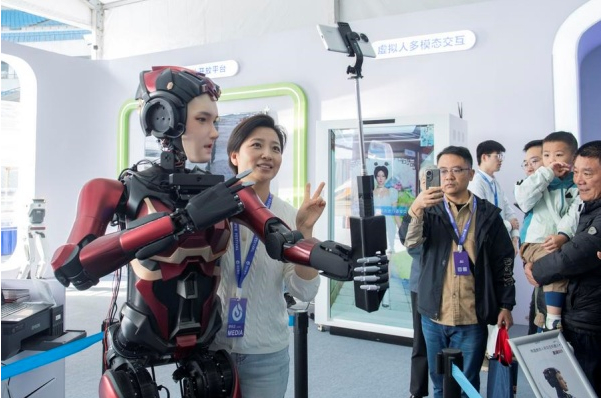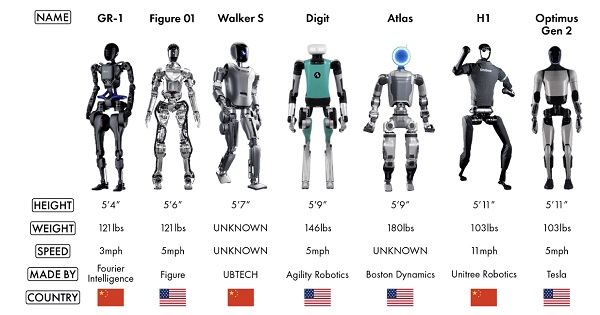Chinese researchers have created a humanoid robot that can run at a remarkable speed of just over 8 miles per hour (mph) or 3.6 meters per second (m/s).
This achievement establishes it as the fastest machine of this type ever built, although these speeds were attained with special footwear.
The bipedal robot, named STAR1, was developed by the Chinese company Robot Era and stands 5 feet 7 inches (171 centimeters) tall with a weight of 143 pounds (65 kilograms).
In a promotional video, a race was staged between two STAR1 robots, one of which wore sneakers to determine if this would enhance its speed in the Gobi Desert located in northwestern China.
The footwear-equipped STAR1, driven by high-torque motors and powered by artificial intelligence (AI) algorithms, successfully navigated various terrains, such as grass and gravel.
During its jog on both paved paths and dirt, STAR1 maintained its maximum speed for 34 minutes.
By reaching a top speed of 8 mph, it surpassed Unitree’s H1 robot, which previously set the record for bipedal robots at 7.4 mph (3.3 m/s) in March 2024.
Although STAR1 benefited from the use of footwear, H1 wasn’t technically in a running or jogging motion, as both of its feet never left the ground simultaneously during movement.

The STAR1 robot achieves its maximum speed of 8 mph thanks to the addition of sneakers.
Scientists have successfully created a new humanoid robot that can attain a peak speed of just over 8 miles per hour (mph) — specifically 3.6 meters per second (m/s). This development makes it the fastest machine of its kind built so far, although these speeds were reached with the assistance of added footwear.
STAR1, engineered by the Chinese firm Robot Era, is a bipedal robot that stands 5 feet 7 inches (171 centimeters) and weighs 143 pounds (65 kilograms).
In a promotional video, the team showcased a competition between two STAR1 robots in the Gobi Desert in northwestern China, with one model equipped with sneakers to assess if this would enhance its speed.
Powered by high-torque motors and AI algorithms, the STAR1 with footwear navigated various terrains, including grassland and gravel, while jogging on both paved and unpaved surfaces, maintaining its maximum speed for 34 minutes.
Achieving a top speed of 8 mph allows it to surpass Unitree’s H1 robot, which held the previous speed record for a bipedal robot at 7.4 mph (3.3 m/s) in March 2024. While STAR1 had the aid of footwear, H1 was not technically jogging or running, as its feet never both left the ground at the same time.
STAR1 is equipped with AI hardware boasting a processing capability of 275 trillion operations per second (TOPS), according to Robot Era’s website. This level of power significantly exceeds that typically found in high-performance laptops, which generally operate between 45 and 55 TOPS. The robot also features 12 degrees of freedom, indicating the number of joints and range of movements it can perform.
The Chinese robotics startup Robot Era has unveiled what it claims to be the fastest humanoid robot on the planet. Named STAR1, it has surpassed Tesla’s Optimus and Boston Dynamics’ Atlas to secure the title of the world’s swiftest humanoid robot.
What distinguishes STAR1 is its remarkable computational capacity. It is designed with AI hardware capable of handling an impressive 275 TOPS, far exceeding the processing capabilities of most contemporary laptops, which are typically between 45 and 55 TOPS. Image Credit: Robot Era.
Humanoid robots are advancing rapidly, progressing beyond household tasks into the realm of impressive new technologies.
The Chinese robotics startup Robot Era has announced what it believes to be the fastest humanoid robot globally. STAR1 has outpaced Tesla’s Optimus and Boston Dynamics’ Atlas to claim the position of the fastest humanoid robot in the world.
STAR1 measures 5.6 feet in height, weighs approximately 143 pounds, and is capable of sprinting at a maximum speed of 8 miles per hour (around 13 km/h). This velocity places it ahead of rivals such as Unitree’s H1 robot, which formerly held the record at 7.4 mph.
To demonstrate its prowess, Robot Era released a video featuring two STAR1 robots racing across the diverse terrain of the Gobi Desert in China. One of the robots even wore sneakers to determine if it could increase its speed.
Equipped with high-torque motors and cutting-edge AI algorithms, STAR1 showcased its capability to traverse various surfaces, such as paved roads, sand, and grasslands.
The video emphasized its agility and speed, indicating that the robot attained its peak velocity within approximately 30 seconds. Thanks to its strong motor system, STAR1 can effortlessly navigate rough terrains, making it suitable for both urban and off-road settings.
What truly distinguishes STAR1 is its computational strength. It’s built on AI hardware that can process an impressive 275 trillion operations per second, significantly exceeding the performance of most contemporary laptops, which generally manage between 45 and 55 trillion operations per second.
Furthermore, STAR1 possesses “12 degrees of freedom,” which pertains to its joints and movement range, enabling highly efficient locomotion.
The robot’s capability for real-time decision-making is enhanced by high-speed communication modules, ensuring instantaneous processing of environmental data. This functionality is vital for its ability to adjust to unpredictable terrains and sustain stability at high speeds.
With STAR1 now gaining attention, Robot Era has elevated the standards in the humanoid robotics competition. While Tesla’s Optimus and Boston Dynamics’ Atlas emphasize different aspects of robotic development, STAR1’s combination of speed, mobility, and advanced AI could redefine benchmarks for future advancements in the field.
As humanoid robots progress, it’s evident they are evolving beyond just smart machines — they’re increasingly resembling athletes as well.
A few months ago, China’s Robot Era showcased the walking abilities of its XBot-L humanoid by allowing it to roam the Great Wall of China. Now, the company has released videos of two flagship Star1 models racing through the Gobi Desert.
Robot Era is a relatively new player in the humanoid robot domain, having originated from Tsinghua University in August 2023. However, the company has already developed several humanoids, including a dexterous human-like hand, and has become quite proficient at showcasing its creations in entertaining promotional videos.
The most recent footage was captured late last month and features the company’s new flagship humanoid robot, Star1. In fact, two of them were seen racing against each other across rocky trails, grassy landscapes, and winding roads through portions of the Gobi Desert. One runs “bare-footed” while the other sports a stylish pair of sneakers.
Unfortunately, there is not much information available about the flagship running robot, but we do know it stands at 1.71 m tall (5.6 ft) and weighs 65 kg (143 lb). Its peculiar running style keeps the body upright and straight while its jointed legs extend forward in a manner likely to be fully approved by the Ministry of Silly Walks.
“Managing a robot’s limbs and dynamic center of gravity is crucial for enabling autonomous navigation across rugged landscapes,” explained Robot Era. “For example, moving over soft or uneven surfaces, like those found in Danxia landforms, requires flexible, adaptive joints that can absorb shocks and adjust to surface imperfections. On the other hand, navigating hard surfaces demands tighter joint control for stability, requiring the robot to adjust the stiffness or flexibility of its joints for smooth movement and fall prevention.”
The company reports that the sneaker-wearing humanoid began the race later but quickly caught up to its rival before taking the lead, reaching speeds of up to 3.6 meters per second (8 mph) for a duration of 34 minutes.
Both robots are equipped with proprietary 400-Nm (295-lb.ft) joint motors that include “precision planetary reducers, high-precision encoders, and drivers,” along with high-speed communication modules. AI computing at up to 275 tops allows them to perceive their surroundings and adapt to different terrains.
“The Star1 utilizes AI and large language model technologies,” stated Robot Era in a press release. “Developed with an end-to-end neural network, the STAR 1 rapidly acquires new skills and adjusts to a variety of tasks. This adaptability allows it to transition between three locomotion modes – running, walking, and jumping – across different surfaces, including roads, grass, deserts, and uneven ground.
“With its integrated AI model, the Star1 is capable of both imitation learning and reinforcement learning. Robot Era has equipped this model with comprehensive walking and running experience through extensive simulation training in virtual settings.”
The company also asserts that it has pioneered the first “denoising world model,” enabling the humanoid to “predict and extract essential environmental data from simulation training, reducing real-world interference with its operations.”
Robot Era claims that this test aimed to demonstrate the robot’s adaptability to genuine natural settings, aligning with its mission to introduce general-purpose humanoids powered by artificial intelligence into homes and workplaces.
There is significant urgency to tap into what is anticipated to be a highly profitable market, with the Star1 being the most recent addition to an ever-growing list of competitors, including Tesla, Figure, Unitree, and Fourier – to name a few.
Robot Era, a newcomer in the humanoid robotics industry, has once again captured the interest of tech enthusiasts through a recent stunt.
After showcasing its XBot-L humanoid walking along the Great Wall of China a few months ago, the company has now shared video footage of two Star1 models racing across the Gobi Desert.
The high-speed desert race reveals an exciting glimpse into the future of humanoid robots designed for actual environmental conditions.

Racing humanoids in the Gobi Desert
The video, recorded late last month, features two Star1 humanoid robots competing over diverse terrain in the Gobi Desert. The robots are shown navigating rocky trails, grassy spots, and winding roads.
One robot runs “barefoot,” while the other wears a pair of sneakers, which, as it turns out, significantly influenced the race’s outcome.
While Robot Era has not disclosed many specifics about the Star1 humanoid robot, a few notable details are known. Standing at 5.6 feet (1.71 meters) tall and weighing 143 pounds (65 kg), the robot moves with a distinctive gait.
Its upright posture remains steady as its jointed legs propel it forward in a manner reminiscent of Monty Python’s “Ministry of Silly Walks.”
During the desert race, the robot in sneakers started behind its counterpart but quickly made up the distance. Robot Era reported that the sneaker-clad Star1 achieved speeds of 8 mph (3.6 meters per second) and managed to maintain the lead for a full 34 minutes.
The race underscores the robots’ ability to traverse uneven terrain effortlessly.
Advanced technology for real-world applications
Robot Era’s humanoid robots are powered by state-of-the-art technology, allowing them to perform impressively in varying environments. Both Star1 models incorporate proprietary 295-lb.ft (400-Nm) motors, which feature “precision planetary reducers, high-precision encoders, and drivers.”
This advanced motor system ensures smooth and efficient motion, essential for navigating rugged landscapes like the Gobi Desert.
Additionally, the robots are outfitted with high-speed communication modules that facilitate real-time data processing.
An AI computing power of up to 275 tops (trillions of operations per second) empowers the robots to perceive their surroundings and adapt to different settings.
This capability represents a significant edge, as it enables the humanoids to handle diverse terrains without losing balance or speed.
The Gobi Desert race demonstrates how these robots can adjust to demanding conditions, reinforcing Robot Era’s goal of deploying humanoid robots in practical, real-world scenarios.
“This trial run will pave the way for its robots to be utilized in a variety of applications,” stated the company. Whether in homes or workplaces, Robot Era aspires to introduce general-purpose humanoid robots powered by artificial intelligence.
A competitive landscape for humanoids
Although Robot Era is a relatively new participant in the humanoid robot sector, it has already made a considerable impact. The company was incubated by Tsinghua University in August 2023 and has since developed multiple humanoid robots, including a dexterous, human-like hand.
Their promotional videos have successfully drawn interest to their robots’ capabilities, with the recent desert race being no exception.
Nevertheless, the competition to lead in the humanoid robot market is intense. Companies like Tesla, Figure, Unitree, and Fourier are also working on humanoid robots intended for everyday tasks. All of these companies are eager to explore what is anticipated to be a highly lucrative market as robots become more integrated into both homes and workplaces.
Robot Era’s Star1 humanoid robot represents the newest innovation in the fast-evolving sector of robotics. This cutting-edge machine not only showcases an impressive array of advanced technological features but also mimics human motion remarkably well, setting it apart as a formidable player in the industry.
As the market sees an influx of humanoid robots from various manufacturers, the competitive landscape is expected to become increasingly fierce, with each new model striving to outperform its predecessors in terms of functionality, versatility, and realism. The Star1 humanoid embodies the potential to redefine human-robot interactions, mark a significant leap forward in robotics, and challenge other contenders as development continues in this dynamic field.
The rise of artificial intelligence has undoubtedly transformed various sectors, from healthcare to education, and the pace of this transformation varies across different regions of the world. While the West often strives for perfection in AI systems before implementation, China has taken a more pragmatic approach, prioritizing speed and adaptability over flawless execution.
China’s economic strategy towards AI development offers valuable lessons that the West can learn from.
First, China’s willingness to take risks and embrace AI’s current limitations has allowed for faster adoption and experimentation. This pragmatic mindset has enabled Chinese companies to rapidly implement AI solutions, even if they are not entirely flawless, and iterate upon them as they go.
Second, China’s desire to be the world leader in AI development has driven a national-level strategy that prioritizes innovation and technological advancement. China’s extensive involvement in the AI ecosystem, both as a policymaker and a participant, has led to a more cohesive and coordinated approach to AI development.
Finally, China’s focus on “common prosperity” in its AI governance strategy suggests a greater emphasis on ensuring the benefits of AI are shared more broadly across society. This holistic approach to AI development, with considerations for societal well-being and sustainability, offers a valuable lesson for the West.
7th World Voice Expo held in Hefei, eastern China’s Anhui Province
“I’m thirsty,” a guest remarked to a tall humanoid robot that stands 1.7 meters high and weighs 65 kilograms at the 7th World Voice Expo held in Hefei, eastern China’s Anhui Province.
Without delay, the black humanoid robot recognized the coffee bottle among the other two items on the table and handed it to the guest.
“Fueled by a large language model, our second-generation humanoid robot is more intelligent and capable of executing more delicate tasks like pouring coffee,” stated Ji Chao, chief robotics scientist at the AI firm iFLYTEK.
According to Ji, iFLYTEK’s superbrain robotic platform has supported 450 robotics companies and 15,000 developers throughout the nation by making the company’s large language model accessible.

The 7th World Voice Expo, which runs from Thursday through Sunday, features over 200 AI products, including humanoid robots, systems for human-machine interaction, and advanced large language models. This event emphasizes the incredible pace of AI development and the increasing use of its applications across diverse scenarios.
Unitree, a robotics startup based in Hangzhou, presented its flagship humanoid robot, Unitree H1, which has a speed of 3.3 meters per second.
“We have sold more than 100 units of this robot, each priced at 90,000 U.S. dollars, showcasing the vast market potential for the full commercialization of humanoid robots,” remarked Li Jun, head of technical services at Unitree.
In China, AI is emerging as a key driver for the evolution of new quality productivity forces. China’s government work report this year introduced an AI Plus initiative, a strategic plan aimed at boosting the growth of the digital economy and leading the modernization and transformation of manufacturing industries.
At the expo, an automatic voice-interaction testing system for new energy vehicles (NEVs) was introduced and attracted considerable attention.
Inside an NEV, a robot communicates with the vehicle as if it were a human passenger. At the same time, an external system monitors and displays the accuracy, stability, and timeliness of the interaction in real time, automatically compiling all gathered data into a comprehensive report.
“Voice interaction is a fundamental function of the intelligent cockpit in NEVs. Previously, this required weeks of human testing during the research and development phase,” explained Wu Jiangzhao, general manager of the National Intelligent Voice Innovation Center. “With this autotest system, the testing duration can be reduced to just two to three days, significantly enhancing intelligent upgrades in the automotive sector.”
“AI is revolutionizing the automotive industry,” stated Yin Tongyue, chairman of the Chinese car manufacturer Chery. From creating vehicles that can talk to developing cars capable of speaking foreign languages for international markets and now introducing a humanized intelligent cockpit system, Chery is capitalizing on the AI surge, he noted.
Various everyday items, including smart refrigerators, AI eyeglasses, and smart cups now incorporate AI large language models, providing users with exciting new experiences.
MiMouse, a high-tech firm based in Anhui, showcased its popular smart mouse at the expo, along with a newly developed smart keyboard powered by large language models.
This keyboard, integrated with several large language models, can instantly generate articles, create PowerPoint presentations, draw images, and perform translations with the press of just a few keys.
“The smart keyboard and mouse can help alleviate repetitive tasks for office workers,” explained Feng Haihong, general manager of MiMouse, adding that they sold approximately 10,000 smart mice within a month.
Owing to the surge in AI, China now has more than 4,500 AI companies. The core AI industry reached over 578 billion yuan (around 81.3 billion U.S. dollars) in 2023, reflecting a year-on-year growth of 13.9 percent, according to official data.
In the future, AI is expected to transform industrial and competitive landscapes, influence scientific research, bring changes across various sectors, and most importantly, fulfill people’s desires for an improved quality of life, said Liu Qingfeng, chairman of iFLYTEK, during the expo.
The country’s robotics industry is reaching a tipping point
The arrival of robots is imminent — whether or not we are prepared. Recent advancements in artificial intelligence (AI) are leading to significant new developments in “humanoid robotics.” Many researchers aim to use brain-inspired neural networks to create machines that replicate human anatomy and performance. Unsurprisingly, much of the work in autonomous and multimodal robots is aimed at substituting human labor.
The robotics sector is approaching a critical juncture. Previously limited to monotonous tasks in manufacturing plants, robots are now gaining the ability to learn from general data to execute intricate human tasks. In contrast to specialized industrial robots, humanoid robots can be engineered for universal applications across various work environments. This encompasses fields like agriculture, manufacturing, mining, healthcare, education, entertainment, and even defense.
Germany and Japan currently dominate this market, but China is rapidly closing the gap. In 2022, Japan represented 45 percent of the global industrial output and 36 percent of worldwide exports, while China had already emerged as the leading consumer of robots, accounting for over half of all installed machines. By 2024, China is anticipated to hold the top position in robotics patent filings, although it still relies on foreign companies. In fact, most major Western robotics companies operate in China due to the vastness of its market.
China’s Ascendancy Is a Strategic Initiative
Last year, a report from China’s Ministry of Industry and Information Technology (MIIT) emphasized the direction of the country’s robotics sector through substantial subsidies and tax benefits. While China is still behind in both software and hardware, its robotics industry is poised to ascend the global value chain. Through its “robotics +” action plan, Beijing aims to expedite the integration of robots across various sectors.
Chinese planners are understandably optimistic about controlling the global supply of essential components for the robotics industry by 2025 and achieving worldwide leadership in humanoid robot production by 2027, as noted by The Robot Report. In the face of China’s sluggish economy, the MIIT identifies robots as a “new engine of economic growth.” Robot sales figures indicate that China is vigorously pursuing labor automation. Increased automation is crucial for boosting productivity in light of an aging and declining population.
Overall, China’s principal advantage in the robotics industry is its low-cost manufacturing. The nation’s domestic firms trail behind foreign competitors in smart manufacturing equipment, industrial software, and operating systems. However, many Chinese companies have created “good enough” alternatives that can be priced at as low as one-fifth of the cost of machines from Western rivals. Indeed, China’s industrial policies are intentionally focused on swiftly expanding a variety of high-tech industries through advanced manufacturing.
Can North America Compete?
Will firms in North America be capable of competing in this emerging sector? It’s challenging to determine. The United States still holds the lead in software development, but Asia has become the key driver of the industry — with 73 percent of the installed robots. The Chinese government has become especially successful at motivating manufacturers to set up near research hubs to adopt leading-edge innovations. These initiatives are designed not only to boost domestic productivity but also to position China as a significant contender in automating manufacturing and services.
While the United States generally excels in innovation, it falls short in implementation. A report from the Information Technology and Innovation Foundation indicates that the U.S. lacks a unified national innovation system. In fact, its overall innovation framework has been declining for decades. Currently, China accounts for a remarkable 35 percent of global manufacturing, compared to the United States’ 12 percent. In 2022, the United States experienced a trade deficit of $1.26 billion in robotics, with exports constituting only 28 percent of the value of imports.
As Chinese technology companies advance in the software value chain, it is crucial for Western policymakers to improve their capabilities in industrial planning. Similar to many other emerging sectors (telecommunications, aerospace, advanced electronics, high-speed rail), Chinese planners have mastered the art of integrating strategic industrial policy with long-term investments.
Getting the Right Industrial Policies in Place
In August 2022, a consortium of Chinese government ministries, including the Ministry of Industry and Information Technology (MIIT), issued a joint statement regarding the use of robots across various industries like agriculture, construction, healthcare, and mining. Robotics is just one aspect of a broader array of public investments aimed at high-risk sectors. China’s “Made in China 2025” industrial initiative, launched in 2015, highlights the nation’s aim to become a leader in global innovation.
Considering the vast size and diversity of the Chinese tech market, it would be prudent for Canadian policymakers to pay closer attention to China’s approach to industrial planning, particularly within its robotics sector. Despite years of investment in innovation policy and strategy, Canada remains at the lower end of its peer group when it comes to innovation. If Canadian manufacturers hope to compete effectively in the global innovation landscape, this must be addressed.
Humanoid robots are considered another potentially disruptive technology following personal computers, smartphones, and new energy vehicles, given their wide-ranging developmental possibilities and applications.
Recently, several prototypes from the “Q family” of humanoid robots, developed by the Institute of Automation at the Chinese Academy of Sciences (CASIA), were publicly showcased in Beijing.
These humanoid robots come with various configurations, each offering different functions and attributes.
During an interview with China Media Group (CMG), a researcher demonstrated the agility of the high-dynamic “Q1” robot, which can comprehend instructions and perform tasks.
The robot is capable of selecting the right vegetable from a collection based on commands such as “pick the starchiest vegetable” or “pick the spicy one.”
“We trained the robot using large language models (LLMs) for two to three months,” explained Chen Meng, a senior engineer at CASIA. “By employing visual recognition, it can independently use logical reasoning to accurately identify which vegetable to select. Additionally, the visual recognition system informs the robot’s movements, enabling it to pick the correct vegetables from a random assortment.”
The Q1 robot also possesses the ability to shoot arrows, which poses a significant challenge for robotic systems.
“The combined weight of its two robotic arms is approximately 15 kilograms. When it shoots an arrow, both arms move forward simultaneously, causing a notable forward tilt in its center of gravity. Consequently, the robot must recalibrate its center of gravity by adjusting the motors in its hip and knee joints to remain stable,” Chen elaborated.
Upon release of the bow, the abrupt loss of force dramatically affects the robot, necessitating adjustments to the 12 motors in each hip joint and the seven motors in each robotic arm to mitigate the impact, Chen stated. “All of these adjustments must be perfectly synchronized to facilitate the precise action of shooting an arrow.”
The “Q family” humanoid robots also exhibited their ability to recharge a cellphone and serve drinks to their instructor.
“In my view, humanoid robot products integrated with LLMs will find many demonstrative uses across different domains, including home services, entertainment, scientific exploration, and manufacturing, within one to two years,” stated Lu Hao, an associate research fellow at CASIA. “In three to five years, they may genuinely become a commonplace element of daily life.”
An AI-Enhanced ‘Big Factory’ for Robot Production
Led by Qiao Hong, an expert at CAS and director of the state key laboratory of multimodal artificial intelligence systems, the research team has created an advanced “big factory” designed to innovate and assemble humanoid robots.
“This factory employs AI technologies to assist in creating a robot tailored to our needs, allowing us only to input the desired application scenarios and tasks,” said Chen.
Through the utilization of AI technologies, the factory can autonomously finish the hardware design and software algorithm selection for the robot based on the specified requirements and make adjustments to optimize the design.
The entire initial prototype design process can now be completed in less than a minute, greatly reducing the current research and development timeline.
Greater Intelligence with an Expanded Range of Applications
China has experienced a significant trend toward the creation of more intelligent humanoid robots, applicable in industrial manufacturing, healthcare, service industries, emergency response, aerospace, and various other areas.
Nevertheless, three conditions need to be fulfilled before these robots see widespread adoption: high performance, affordability, and mass production capabilities.
To develop products that are both high-performance and cost-effective, Qiao mentioned that they have assembled a research team focused on creating components and parts. “We’ve been investigating ways to substitute some imported components with those produced domestically to further cut costs,” she stated.
Nonetheless, the most vital challenge is ensuring the robot’s ability to operate consistently. “Are we able to combine software and hardware solutions to create a system that is high-performing, low-cost, and highly reliable? If that’s achievable, we can progress toward practical applications,” remarked Qiao.
China has accelerated the industrial development of humanoid robots. In October 2023, the Ministry of Industry and Information Technology released guiding principles for the innovative progression of humanoid robots, aiming to establish an initial innovation framework for these robots by 2025 and attain breakthroughs in crucial technologies such as the “brain, cerebellum, and limbs” of robots.
The goal is also to significantly enhance the technological innovation capabilities of humanoid robots, create a safe and dependable industrial supply chain, and develop a competitive industrial ecosystem on an international scale by 2027.

Tiangong, identified as the first full-sized humanoid robot in the world that operates solely on electric power, was introduced in the Beijing Economic-Technological Development Area on Saturday, coinciding with the announcement of various AI technological advancements at the 2024 Zhongguancun Forum (ZGC Forum).
Tiangong is capable of maintaining a constant speed of six kilometers per hour. Created by the Beijing Humanoid Robot Innovation Center Company, this robot represents an independently developed humanoid robot platform ready for wider industry implementation.
Standing at 163 centimeters tall and weighing just 43 kilograms, Tiangong is furnished with numerous visual perception sensors and possesses a computing power of 550 trillion operations per second.
The robot has already showcased running abilities similar to those of humans and provides open-source compatibility for further enhancements, enabling wider commercial usage, as indicated in a developer briefing.
According to Xinhua News Agency, the company was officially registered in the Beijing Economic-Technological Development Area and was established collaboratively by businesses engaged in complete robots, core components, and large robot models.
At the ZGC Forum, which is a national-level event for global dialogue and collaboration highlighting China’s swift progress in advanced innovation and technologies, various AI robot products were revealed, including the intelligent humanoid Tongtong developed by the Beijing Institute for General Artificial Intelligence.
Seán Ó hÉigeartaigh, the founding Executive Director of Cambridge’s Centre for the Study of Existential Risk, commented at the event that the AI technological advancements presented at the ZGC Forum, including the intelligent humanoid Tongtong, were impressive and surpassed expectations. “I am quite optimistic about the prospects of the Chinese AI industrial sector. One of the things that China has excelled at is developing AI in a way that integrates into everyday life, providing meaningful and useful tools to people,” stated Seán Ó hÉigeartaigh.
In Shanghai, the first governance guidelines for humanoid robots in China have been issued, emphasizing the importance of risk management and international collaboration as technology companies like Tesla showcased their own robots at the nation’s largest AI conference.
Manufacturers of humanoid robots are urged to ensure that their products “do not jeopardize human security” and “adequately protect human dignity,” according to the new guidelines published in Shanghai during the World Artificial Intelligence Conference (WAIC) on Saturday.
These guidelines also recommend implementing measures such as establishing risk warning protocols and emergency response systems, alongside providing users with training on the ethical and legal usage of these machines.
The document was authored by five industry organizations based in Shanghai, which include the Shanghai Law Society, the Shanghai Artificial Intelligence Industry Association, and the National and Local Humanoid Robot Innovation Centre.
The organizations are also advocating for global collaboration within the humanoid robot sector by suggesting the formation of a global governance framework and an international think tank dedicated to overseeing these machines.
Last weekend, around 300,000 people attended the largest artificial intelligence event in China, held in Shanghai. However, it was the humanoid robots that attracted significant interest from many visitors.
At the World Artificial Intelligence Conference, eighteen Chinese-made robot models welcomed attendees, while many lined up to witness the debut of Tesla’s latest Optimus humanoid robot model inside the exhibition hall.
Among the bipedal robots showcased was a model named Qinglong, developed by a Shanghai research lab using technology that has now become open source, which demonstrated its capability of sorting bread and fruits into separate baskets.
The excitement surrounding humanoid robots extends to the highest levels of government in China. Last November, the Ministry of Industry and Information Technology released an industry blueprint that includes a goal to mass produce humanoid robots by 2025, envisioning them as “a new engine of economic growth” by 2027.
China has made significant advances in robotics within a short period, positioning its companies and researchers to compete with U.S. industry leaders like Boston Dynamics and Tesla. However, despite Beijing’s aspirations, challenges still exist before humanoid robots can be commercially deployed, including the need for technological refinement and determining practical applications, all while facing difficulties in obtaining essential materials like U.S.-made chips due to ongoing geopolitical strains.
“We are currently experiencing a remarkable expansion in the size and range of this industry,” states Ni Tao, a tech blogger based in Shanghai. “However, there is currently a lot of hype surrounding this area, and we are starting to see early indicators of a potential bubble.”
Though the technology to produce humanoid robots has existed for over ten years, recent advancements in artificial intelligence have allowed them to acquire new abilities, making them smarter, more adaptable, and easier to train.
China, which is turning to automation as a solution to its declining workforce, has already deployed more industrial robots than any other country. However, various industries are now seeking more advanced models, such as humanoid robots capable of performing more intricate tasks.
Warehouse logistics and automotive manufacturing are among the initial sectors where Chinese companies have begun experimenting with humanoid robots. For example, UBTech Robotics, based in Shenzhen, went public in Hong Kong last December, raising about $130 million. Earlier this year, it started pilot tests at the motor assembly line of the electric vehicle manufacturer NIO, where its robot, dubbed Walker S, was responsible for checking door locks and attaching car emblems.
Recently, the company has announced similar partnerships with the state-owned Dongfeng Motor and the joint venture FAW-Volkswagen with the goal of eventually creating a fully automated car factory.

China is also looking to integrate humanoid robots into healthcare and elderly care, where they could help mitigate potential labor shortages due to an aging population. Some companies, like Dalian-based Ex-Robots, focus on giving their robots a hyper-realistic appearance with silicone faces, hoping that, in addition to tasks like floor cleaning or transferring patients, they may one day also provide companionship for seniors.
As humanoid robots capture the attention of the tech sector, substantial investments are pouring in. According to the Chinese research firm AskCI, local humanoid designers and manufacturers raised 5.4 billion yuan ($742 million) in new funding last year, more than quadrupling the amount from the previous year.
“It’s intriguing because this market segment has not yet seen significant commercial success,” observes Ash Sharma, a research director at the UK-based market intelligence firm Interact Analysis. “Yet, at the same time, there has been enormous investment in these kinds of products.”
However, commercial viability may not be far off. Unitree Robotics, a prominent startup from Hangzhou that secured $139 million in its latest funding round last February, launched its humanoid model, the G1, in May. Priced at $16,000, it is less than one-tenth the cost of other offerings available in the market.
“It was a significant development for this industry, forcing companies like Boston Dynamics and Tesla to adjust their pricing strategies,” comments George Chowdhury, an analyst at the technology intelligence firm ABI Research. Unitree did not reply to a request for comments.
While state support and a generally favorable regulatory environment have been advantageous for Chinese firms thus far, there are still gaps in some of the essential elements of the technology, particularly in robot hardware.
“Although Chinese companies or startups can sometimes manufacture these components in-house or source them from local suppliers at a lower cost, the quality of precision, durability, and other specifications are sometimes inferior to those from imports,” remarks Ni, the tech blogger.
More critically, many Chinese developers rely on foreign chips and technologies to operate their robots, making the industry susceptible to U.S. export restrictions and sanctions—especially considering the significance of chips produced by the American company Nvidia.
“The familiarity that Nvidia has established over the years within the [humanoid] developer community and the unparalleled support they have offered is unmatched in the industry,” asserts Lian Sye Su, chief analyst at the tech research firm Omdia.
Chinese humanoid robots were among the nine robots that shared the spotlight with Nvidia CEO Jensen Huang during his keynote speech at the company’s annual AI conference in March. These included Unitree’s H1, Xpeng’s PX5, and GR-1, which was developed by Fourier Intelligence, a Shanghai-based company specializing in rehabilitation robotic devices that expanded into humanoid robots last year.
For instance, UBTech Robotics has only sold 10 units of its Walker series since 2021, according to its IPO prospectus, and currently depends on revenue from education and logistics robots. The company chose not to comment.
“Innovation will continue, but it is uncertain when these technologies will achieve commercial and economic value on any meaningful scale,” adds Chowdhury.
Despite this, many industry professionals remain hopeful about the prospects for humanoid robots. David Hanson, founder of Hanson Robotics, which created the social humanoid robot Sophia in 2016, notes that these machines are now generating their own data and learning from their experiences.
“It’s important to maintain perspective regarding the significant changes we are witnessing in the fields of development and technology, especially in AI and robotics. As Hanson points out, although some robots may not yet be capable of performing the advanced tasks we often see showcased in viral videos or may be overly hyped by marketing strategies, this should not overshadow the genuine progress taking place.
We are currently experiencing a transformative wave in AI and robotics that is fundamentally altering various aspects of our lives and industries. This momentum is not fleeting—it will continue to evolve and shape the future in unprecedented ways.”


